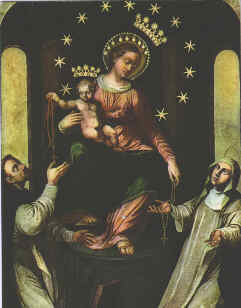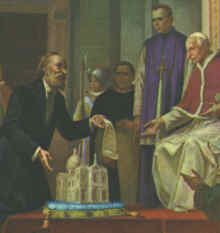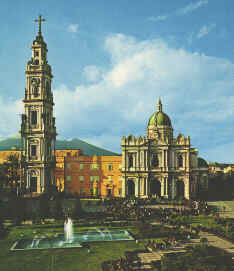Our Lady of Pompeii
Our Lady of Pompeii
— M. Jean Frisk, S.S.M.
Image
Five minutes from the ruins of Pompeii, Italy, the great Roman city destroyed by the volcano of Mt. Vesuvius, there is a an area called Valle di Pompeii where the town of Campania is located. In the shadow of the ancient volcano, a Marian Shrine was erected in the latter half of the 1800s. The shrine is dedicated to Our Lady of the Rosary, named for the Marian image elevated on its high altar.

The image represents Our Lady of the Rosary. It is a variation of the Marian icons representing Mary enthroned. She is the reigning Madonna. She reigns but she is herself the throne of the King of kings, Jesus Christ, her son. He extends his blessing hand and at the same time bestows the blessing of the rosary on the saint at his feet. The Pompeii image is a derivation of the Eastern icon type traced back to the sixth century. Both in the East and West, the image represents Mary as Queen of Heaven. The throne is usually situated in a church, as is this one in the image of Our Lady of Pompeii.
Origin
Pompeii was destroyed in 79 AD. In the fourth century, Christians settled in the area. Early records indicate that a large church dedicated to the Most Holy Savior was erected there, and by the eleventh century entrusted to the care of the Benedictines. In time, the church was destroyed and a small chapel built on the site. The lands were eventually ceded to a Neapolitan noble who allowed the property to deteriorate. Local inhabitants acquired the right of patronage, and Valle di Pompeii became one of eighteen parishes in Italy where the priest was elected by the people.
An article written in 1891 discovered in the files of The Marian Library/International Marian Research Institute states: "The church twenty years ago was small and dilapidated; the poverty of the place made a school an impossibility; the inhabitants were superstitious and criminal, many of them being thieves." It was a layman and his wife who would change the face of Valle di Pompeii.
Bartolo Longo, founder of the Shrine of Our Lady Queen of the Rosary, was born in 1841, the son of a doctor. Longo studied to be a lawyer. During his studies, he joined a sect and was ordained as a priest of Satan. He publicly ridiculed Christianity and did all in his power to subvert Catholic influence. A good friend, Vincent Pede, eventually showed Bartolo the gentleness of Christ and arranged for him to meet a saintly Dominican priest, Alberto Radente. The Dominican had a deep, personal devotion to Mary and fostered the devotion of the rosary.
When Bartolo Longo was baptized, he chose the second name, Maria, to be his baptismal name. He saw Mary as a 'Refuge of Sinners' and attributed his miraculous conversion to her. She was the 'Refuge' who would lead him to Christ. After his conversion, Bartolo Maria Longo wanted to do penance for his past life and serve the Church he had so viciously slandered. He made a promise to work for the poor and destitute. He also published a pamphlet entitled, The Rosary of New Pompeii and did all in his power to spread the devotion.
One evening, as he walked near the ruined rat- and lizard-infested chapel at Pompeii, he had a profound mystical experience. He wrote:
As I pondered over my condition, I experienced a deep sense of despair and almost committed suicide. Then I heard an echo in my ear of the voice of Friar Alberto repeating the words of the Blessed Virgin Mary: "If you seek salvation, promulgate the Rosary. This is Mary's own promise." These words illumined my soul. I went on my knees. "If it is true ... I will not leave this valley until I have propagated your Rosary."
Bartolo Maria persuaded people of the area to help him clean out the dilapidated church. Then he invited the people to join him one evening to pray the rosary. Only a few curious children came.
Despite the fact that the intrepid disciple of the rosary visited every hut and farm house to distribute rosaries, medals, and encouragement, his apostolate met with meager success. The people loved and respected Don Bartolo, but they neither understood nor cared to learn about the rosary.
Bartolo then sponsored a festival on the Feast of the Holy Rosary in 1873. His first effort failed. It rained, and the preacher spoke in classical Italian instead of the local dialect which the people understood. He tried the next year; he wasn't much more successful, but he had taught some of the people to pray the rosary. The third year, he invited the Redemptorist Fathers to hold a two-week mission. In preparation, he fully restored the little church. The mission, blessed by the bishop, was a successful revival. It was, in fact, the bishop who envisioned a large church and pilgrimage place in the future.
Bartolo began the project by first hunting for a picture of Our Lady of the Rosary. The only one he could afford was an oleograph on paper. At the time, church law required sacred images to be painted in oils on canvas or wood. He was told about a painting of Our Lady of the Rosary being kept in a convent that had been purchased in a junk shop for 3,40 Lire. Longo described it himself:
Not only was it worm-eaten, but the face of the Madonna was that of a coarse, rough country-woman ... a piece of canvas was missing just above her head ... her mantle was cracked. Nothing need be said of the hideousness of the other figures. St. Dominic looked like a street idiot. To Our Lady's left was a St. Rose. This I had changed later into a St. Catherine of Siena ... I hesitated whether to refuse the gift or to accept ... I took it.
Queen of the Valley by Martin A. Stillmock

The image was too large to carry from Naples to Pompeii, but the Bartolo finally found someone who would take it to the chapel for him. When it arrived, it was lying on a wagon of manure. An attempt was made by an amateur to restore it, and it was placed in the church on February 13, 1876, the foundation day for the Confraternity of the Holy Rosary there. In 1880 the famous Italian painter, Federico Madlarelli, offered to restore the image. It was again finally restored by Vatican artists in 1965.
Miraculous Character
The image was first placed in the small, restored chapel in 1875, but plans were made to build a large church worthy of Our Lady of the Rosary. Three hundred people of the area pledged a penny a month for Our Lady's work. The cornerstone laying was held on May 8, 1876. Within the month, miraculous events began to take place at the shrine. Four healings were recorded. From that time on, especially between 1891 and 1894, hundreds of miracles have been officially recorded at the sanctuary. When the construction was completed in 1883, Bartolo appealed to the people:
In this place selected for its prodigies, we wish to leave to present and future generations a monument to the Queen of Victories that will be less unworthy of her greatness but more worthy of our faith and love.
In 1894, Bartolo and his wife, Countess Marianna Farnararo De Fusco, gave the new church to the papacy, in whose care the shrine has remained since. The image was crowned immediately after its enthronement on the inauguration day of the opening of the new shrine.
In 1965, after the third restoration of the image, Pope Paul VI said the following during a homily: "Just as the image of the Virgin has been repaired and decorated, ... so may the image of Mary that all Christians must have within themselves be restored, renovated, and enriched." At the end of this solemn celebration, Pope Paul VI placed two new precious diadems on the heads of Jesus and Mary, crowns that had been offered by the people.
Devotion
During the time when the pilgrimage church was being built, Bartolo Maria Longo began to undertake many works of charity. He and his wife established an orphanage for little girls. The first children he took in were fifteen small orphans, one for each decade of the rosary. He also established a hospice for boys, sons of prisoners, and a corresponding hospice for girls. He founded the Daughters of the Holy Rosary of Pompeii, a religious women's institute to care for the shrine and the educational houses attached to it. He also established the Dominican Tertiaries near the shrine.
A special devotion known as the Supplication to the Queen of Victories was begun on October 1883 and is recited all over the world, especially on May 8 and on the first Sunday in October. The devotion includes a request thought to have been given by Our Lady to one of the children healed at Pompeii, "Whoever desires favors of me should make three novenas of petition and three of thanksgiving."
On October 21, 1979, Pope John Paul II visited Pompeii. The gathering was a national pilgrimage to Our Lady of Pompeii. On October 26, 1980, Bartolo Longo was beatified by John Paul II and called 'the man of the Madonna' and the 'Apostle of the Rosary'.
Meditation

The image of Our Lady of the Rosary represents the long tradition of the faithful who turn to Mary for refuge and hope in their needs. Mary is the throne for her small Son, Jesus. He found his first home on earth within her womb and on her lap. Mary is seated on a throne. It is the throne of the Church. Mary with her divine son reigns in the Church and from the Church, sign of heaven's continuation on earth.
But what church is it? The church in the painting's background is formed of simple, plain lines.The throne is of wood, not the highly carved wood of the period found in wealthy homes, but the wood of the poorer people. The Madonna's feet rest on a plain pedestal, not a cushion of velvet. The people of Pompeii wished to honor the Son and his mother by erecting a magnificent shrine of stone. The shrine of beauty, golden decorations, and sacrificed jewels was the way the culture of the time expressed their love and devotion. Bartolo Longo, however, knew that shrines of stones must be built by the living stones of charity and peace. It was his first intention to teach the people to pray, then to care for their needs.
Each of the rosaries in the painting has six decades.This, too, was the custom of the time. Many times, this sixth decade was prayed for the intentions of those caring for the Church and the apostolic works of the Church. Whatever form the rosary devotion takes, it remains a prayer of Sacred Scripture.The unknown artist of the image has not forgotten this truth. A book is painted at the base of the throne. Our eye moves to this point, away from the pearls and gold, to the book containing the wisdom of God among us, the reality of the Virgin and the Word Made Flesh who dwells among us.
Images shown:
A painting of Bartolo Longo presenting the shrine of Our Lady of Pompeii to Pope Leo XIII,February 19, 1894
The Shrine of Our Lady of the Rosary, Pompeii, Italy, The present structure was begun in 1934 at the request of Pope Pius XI.
All About Mary includes a variety of content, much of which reflects the expertise, interpretations and opinions of the individual authors and not necessarily of the Marian Library or the University of Dayton. Please share feedback or suggestions with marianlibrary@udayton.edu.
